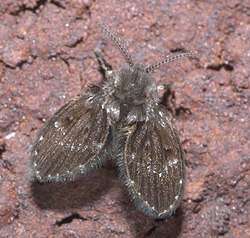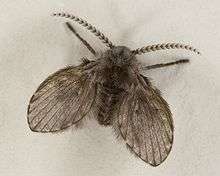Clogmia albipunctata
Clogmia albipunctata is a species of drain fly, a member of the family Psychodidae commonly known as the bathroom moth midge, bathroom moth fly or drain fly.[1]
| Clogmia albipunctata | |
|---|---|
 | |
| Imago of Clogmia albipunctata | |
| Scientific classification | |
| Kingdom: | |
| Phylum: | |
| Class: | |
| Order: | |
| Suborder: | |
| Family: | |
| Genus: | |
| Species: | C. albipunctata |
| Binomial name | |
| Clogmia albipunctata (Williston, 1893) | |
Distribution
This very common species has a worldwide distribution in tropical and temperate areas and is often associated with humans.[2][3]

Description
Clogmia albipunctata can reach a length of 3–5 millimetres (0.12–0.20 in). Both the body and the wings are covered with thick gray-brown hair. The wings are pointed, and have some white spots (hence the Latin species name). Despite being a Diptera (a fly), it has a similar appearance to that of a small moth. The antennae show dense setae, each segment with separate whorls.
Biology
The adults do not feed and live for about 12 days. They spend most of their life perched on walls. They move rarely, and with weak flight. The larvae live in aquatic environments, feeding on organic decaying matter, and take about 18 days to turn into a pupa, which develops into an adult after 5 days.[4] They often infest drains of bathrooms and, for this reason, they are also known as "bath flies" in the United States.
Although they are considered harmless, some cases of myiasis caused by the larvae of this insect are reported in the literature, at the nasal, intestinal and urinary levels but are often associated with very poor sanitary conditions and bad hygiene habits.[5][6][7]
References
| Wikispecies has information related to Clogmia albipunctata |
| Wikimedia Commons has media related to Clogmia albipunctata. |
- BioLib
- The Diptera Site
- Faulde, M.; Spiesberger, M. (2013). "Role of the moth fly Clogmia albipunctata (Diptera: Psychodinae) as a mechanical vector of bacterial pathogens in German hospitals". Journal of Hospital Infection. 83 (1): 51–60. doi:10.1016/j.jhin.2012.09.019. ISSN 0195-6701.
- Dearden, Peter K.; Jiménez-Guri, Eva; Wotton, Karl R.; Gavilán, Brenda; Jaeger, Johannes (2014). "A Staging Scheme for the Development of the Moth Midge Clogmia albipunctata". PLoS ONE. 9 (1): e84422. doi:10.1371/journal.pone.0084422. ISSN 1932-6203. PMC 3883683. PMID 24409296.
- Nevill, E. M.; Basson, P. A.; Schoonraad, J.H.; Swanepoel, K. (1969). "A case of nasal myiasis caused by the larvae of Telmatoscopus albipunctatus (Williston) 1893 (Diptera: Psychodidae)". South African Medical Journal. 43 (17): 512–514.
- Tu, WC; Chen, HC; Chen, KM; Tang, LC; Lai, SC (2007). "Intestinal myiasis caused by larvae of Telmatoscopus albipunctatus in a Taiwanese man". Journal of Clinical Gastroenterology. 41 (4): 400–402. doi:10.1097/01.mcg.0000212615.66713.ba.
- Kamimura, K; Arakawa, R (1986). "A case report on urinary myiasis due to the moth fly Telmatoscopus albipunctatus". Medical Entomology and Zoology. 37 (2): 161–162. doi:10.7601/mez.37.161.